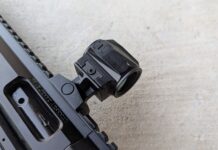Henry and Josh at 9-Hole walk us through stretching a 12.4″ barreled 5.45×39 AK without a floated barrel through the practical accuracy course. They cleaned it to 500 yards nailed and a third round impact at 650. Optic suite is an EOTech with a magnifier. As someone who just found an elusive 13″ 5.45 and ordered it, so I can have my ‘AK-12 at home’ properly, this showing of potential made me quite happy.
What range would you consider effective on an 11-13 inch rifle? Especially running a reflex style optic?
Largely from third hand anecdotal experience and the limits of our own applied knowledge and skills we tend to under estimate how well a rifle can do. We assign values we think are correct, based upon things we think we know, because we think they are reliably sourced. Then someone real worlds our thinking with some well sourced and found hard data and thinking needs to change.
The Mythical ‘300’ Limit
The 300 yard/meter ‘rule’ is no such rule. It is an analytical average that has been simplified from a number of sources into sadly oversimplified fuddlore. It started with the Allies examinations of combat distances after the 2nd World War and was further bolstered from data and choices in the conflicts since then. Vietnam, the Gulf War, GWOT, and plenty of non-US involved conflicts have continued to bolster ‘300’ as the number. But it is the number in the hands of most average users and that average is weighted, more mode than mean, by being the most common range we see as the limit.
In short, shooters (not rifles) are usually only effective out to 300 yards/meters. The human factor tends to be the most limiting factor. Within that human factor must be factored the proficiency of the people, much of our data on a lot of different firearms comes from observing very poorly trained users of the firearms. Again mode, not median. What is the most common limit?
Then ask what are the proficient limits?
The AK may be so easy a conscript (or child) can “use it” in the sense of making it function in vaguely the correct direction. Proficient use, operation in the hands of someone who knows the idiosyncrasies of the machine is different. Knowing not to put pressure on the handguard because it will flex the barrel in the case of the 105 here or conventional M4 or M16 rifles shows through with an entirely different envelope of efficacy. Bracketing all users and then bracketing just proficient users will yield two very different sets of data. The effective range and control efficiency, probably your two most important factors, will tally out very differently between these two groups of users.
Proficient vs ‘Qualified’
Unfortunately trying to bracket ‘proficient’ users as a benchmark is incredibly difficult, especially when you have groups that are titled ‘qualified’ but are not proficient. That problem is rampant within the armed forces and police forces of the US, a simplistic ‘qualification’ standard that a candidate is allowed to keep swinging at until they hit the minimum score once for a one year period. That is not proficiency, it is indemnification against liability.
Not all hope is lost. The new military qualifications and manuals on individual weapons handling are quality material written and vetted by proficient users. They can assist in making you a proficient user too. The same is true of the more challenging police qualifications. They hold you to a standard that is actually high enough to make a difference.
In looking at defensive qualifications you have to look at the factors that go into combat shooting. Not just hitting a target, even the right sized targets, but doing so to a reactive time standard for the distance is important. On demand performance. Almost more important (not quite, but almost) is the ability to fix your gun if it goes down. This includes reloads, soft stoppages, and hard stoppages. A qualification should, ideally, test all of these to a reasonable standard and with a high enough round count to produce data without being overly fatiguing or absurd. Rounds cost money though, and organizations count money more than the intangibles of structured learning that only show through in really bad circumstances. Shooting proficiency is extremely, vitally, life and death important, but it is also “rarely” important so it takes a lower seat with bean counters. This is more true if bean counters who have never been on the sharp end are left in charge, there is never a way that ammo looks like an in the black/green expenditure on a spread sheet.
Instructors will care that you are proficient, the accountant will only care that you are ‘qualified’.
In conclusion,
The rifle will do what you ask it to and you can probably ask more than you think.



